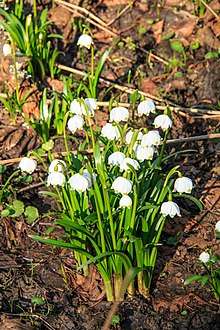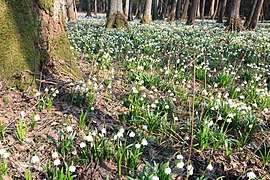Leucojum vernum
Leucojum vernum, called spring snowflake,[2] is a perennial bulbous flowering plant species in the family Amaryllidaceae that includes the onions, daffodils and Agapanthus.[1] It is native to central and southern Europe from Belgium to Ukraine. It is considered naturalized in north-western Europe, including Great Britain and parts of Scandinavia, and in the US states of Georgia and Florida. It is cultivated as a spring-flowering ornamental bulbous plant. Usually a single white flower with greenish marks near the tip of each tepal is borne on a stem about 10–20 cm tall, occasionally more.
| Spring snowflake | |
|---|---|
 | |
| Scientific classification | |
| Kingdom: | Plantae |
| Clade: | Tracheophytes |
| Clade: | Angiosperms |
| Clade: | Monocots |
| Order: | Asparagales |
| Family: | Amaryllidaceae |
| Subfamily: | Amaryllidoideae |
| Genus: | Leucojum |
| Species: | L. vernum |
| Binomial name | |
| Leucojum vernum | |
| Synonyms[1] | |
| |
Description
Leucojum vernum is a perennial bulbous plant, 12–35 cm tall in flower. Its leaves, which appear at the same time as the flowers and continue to elongate during flowering, are 5–25 mm wide and 10–25 cm long, generally reaching to below the level of the flowers. The flowering stem (scape) has a small central cavity and two narrow wings. The pendant flowers appear in spring and are usually solitary, rarely in an umbel of two. The flowers have six white tepals, each with a greenish or yellowish mark just below the tip. Each tepal is 15–25 mm long. The whitish seeds are about 7 mm long.[2][3][4]
- At the start of flowering
.jpg) Typical form with green marks on the tepals
Typical form with green marks on the tepals.jpg) Flower with yellow rather than green marks
Flower with yellow rather than green marks In habitat in damp forest in the Králova Zahrada Nature Reserve, Czech Republic
In habitat in damp forest in the Králova Zahrada Nature Reserve, Czech Republic- Naturalized in a park
Taxonomy
Leucojum vernum was first described by Carl Linnaeus in 1753.[1][5] The epithet vernum means "of the spring".[6]
Varieties
Two varieties are accepted by the World Checklist of Selected Plant Families:[7]
- Leucojum vernum var. carpathicum Sweet – Carpathian Mountains (Czech Republic, Romania, Ukraine)
- Leucojum vernum var. vernum
L. vernum var. carpathicum is distinguished by presence of yellow rather than greenish markings at the tip of each tepal. Some botanists also recognize var. vagneri, with two flowers per scape.[2]
Distribution and habitat
Leucojum vernum is native to central Europe and parts of southern and western Europe, including Austria, Belgium, the Czech Republic, Slovakia, Germany, Hungary, Poland, Switzerland, France, Italy, Romania, former Yugoslavia and the Ukraine. It has become naturalized in other parts of Europe, including Great Britain, the Netherlands and parts of Scandinavia, and in Georgia and Florida in the United States.[1][2] It is found in damp and shady habitats, including woods, up to elevations of 1600 m.[2]
Cultivation
Leucojum vernum is cultivated as an ornamental plant for its white flowers in spring. It is described as "easy to grow", either in sun or partial shade, particularly in moist soil and in grass.[3] The species has gained the Royal Horticultural Society's Award of Garden Merit.[8]
Toxicity
All species of Leucojum are poisonous, as the leaves and bulbs contain the toxic alkaloids lycorine and galantamine.[9] Galantamine is used for the treatment of cognitive decline in mild to moderate Alzheimer's disease and various other memory impairments.[10][11]
References
- "Leucojum vernum". World Checklist of Selected Plant Families. Royal Botanic Gardens, Kew. Retrieved 2017-12-20.
- Grey-Wilson, Christopher; Mathew, Brian & Blamey, Marjorie (1981). Bulbs : the bulbous plants of Europe and their allies. London: Collins. p. 136. ISBN 978-0-00-219211-8.
- Mathew, Brian (1987). The Smaller Bulbs. London: B.T. Batsford. p. 121. ISBN 978-0-7134-4922-8.
- Webb, D.A. (1980). "Leucojum vernum". In Tutin, T.G.; Heywood, V.H.; Burges, N.A.; Valentine, D.H.; Walters, S.M. & Webb, D.A. (eds.). Flora Europaea, Volume 5: Alismataceae to Orchidaceae. Cambridge University Press. p. 77. ISBN 978-0-521-06662-4.
- Linnaeus, Carl (1753). "Leucojum". Species Plantarum. vol. I. p. 289. Retrieved 2017-12-20.
- Hyam, R. & Pankhurst, R.J. (1995). Plants and their names : a concise dictionary. Oxford: Oxford University Press. p. 518. ISBN 978-0-19-866189-4.
- "Search for Leucojum vernum". World Checklist of Selected Plant Families. Royal Botanic Gardens, Kew. Retrieved 2017-12-20.
- "RHS Plant Selector - Leucojum vernum". Retrieved 19 February 2020.
- Straley, Gerald B. & Utech, Frederick H. "Leucojum aestivum". In Flora of North America Editorial Committee (ed.). Flora of North America (online). eFloras.org. Retrieved 2017-12-17.
- "Galantamine". Drugs.com. 2017. Retrieved 2017-12-18.
- Birks, J. (2006). "Cholinesterase inhibitors for Alzheimer's disease". The Cochrane Database of Systematic Reviews (1): CD005593. doi:10.1002/14651858.CD005593. PMID 16437532.
External links

